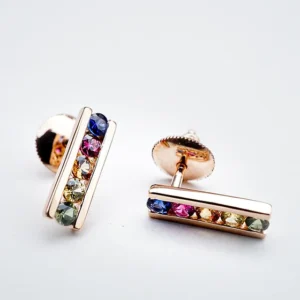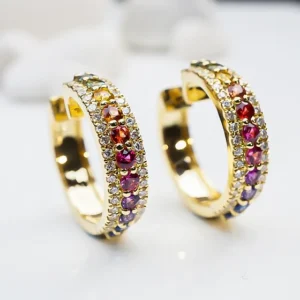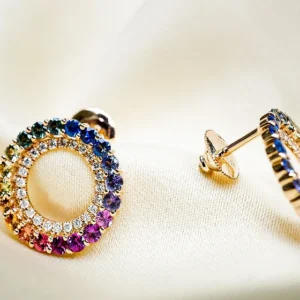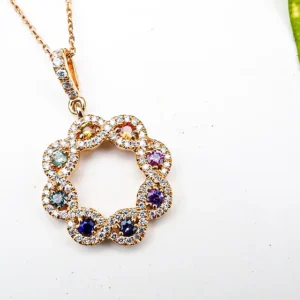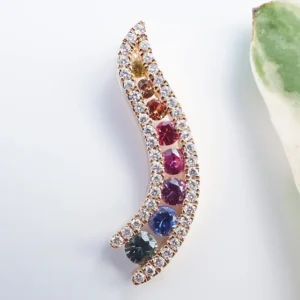Round Cut Diamonds: A Brilliant Choice for Timeless Elegance
Diamonds have long been celebrated as symbols of eternal love and beauty, and among the various diamond cuts available, the round cut diamond stands as a classic favorite. With its unmatched brilliance and timeless elegance, round cut diamonds continue to capture hearts and grace countless jewelry pieces.
Table of Contents
In this article, we’ll delve into the captivating world of round cut diamonds, exploring their history, characteristics, popularity, and much more.
Introduction
When it comes to expressing everlasting love and celebrating milestones, the enduring allure of round cut diamonds has made them a beloved choice for centuries. These exquisite gems stand as timeless witnesses to the most cherished moments in people’s lives, reflecting the depth of emotions and commitment shared between individuals.
Crafted with meticulous precision, the round cut diamonds showcase an unparalleled brilliance that seems to illuminate every memory they accompany. Each facet is thoughtfully positioned to capture and refract light from every direction, igniting a mesmerizing interplay of fiery flashes and radiant sparkle.
As these round cut diamonds grace engagement rings, wedding bands, and other meaningful jewelry pieces, they not only symbolize the eternal bond between loved ones but also cast a radiant glow upon the unique journey of each relationship.
Round Cut Diamonds
A round cut diamond, brilliantly reflecting light from its facets.
A Brief History of Round Cut Diamonds
The round cut diamond’s journey dates back to the 17th century, a pivotal era in the evolution of diamond craftsmanship. During this period of discovery and innovation, diamond cutters embarked on a quest to unveil the hidden potential within these precious gemstones.
Driven by a desire to amplify their innate radiance, these artisans ventured into the realm of innovative shaping, meticulously experimenting with various facets and angles.
As the decades rolled on, their unwavering dedication led to remarkable breakthroughs in technology and cutting techniques, paving the way for the round cut diamond to ascend to its current status as a symmetrical masterpiece. Each facet was painstakingly designed to optimize light reflection, resulting in a dazzling display of brilliance that transcends time.
This journey of refinement mirrors the artistry of human ingenuity, transforming raw diamonds into mesmerizing gems that celebrate life’s most significant moments.
Characteristics of Round Cut Diamonds
Brilliance and Sparkle
Round cut diamonds possess an unparalleled ability to transform light into a mesmerizing symphony of colors that seem to come alive within the heart of the gem. This captivating play of light, often referred to as “fire,” infuses each diamond with a magical radiance that enchants the beholder.
The secret behind this breathtaking brilliance lies in the meticulous arrangement of facets that adorn the diamond’s surface.
As light gracefully enters the stone, it encounters these precisely angled facets, each strategically positioned to capture and refract the light waves. This intricate dance of reflection and refraction results in an ever-changing kaleidoscope of colors that seem to move and twinkle with the slightest motion.
From the icy glint of blue to the fiery hues of red and orange, the round diamond’s facets work harmoniously to channel and amplify the natural beauty of light, imbuing the gem with a radiant allure that is nothing short of enchanting.
Facet Arrangement
With a meticulously crafted arrangement of 58 or 57 facets, the symphony of facets that adorn a round brilliant cut diamond forms an intricate ballet of light manipulation, each facet playing its unique role in orchestrating the gem’s exceptional brilliance.
The crown facets, gracing the upper portion of the diamond, work as master conductors, capturing light and artfully directing it towards the heart of the stone.
The girdle facets encircle the diamond, like supportive ensemble players, collaborating to amplify the light’s journey through the gem. Finally, the pavilion facets, nestled beneath the crown, embrace the role of reflective dancers, ensuring that the light encounters multiple internal reflections, thereby enhancing its radiant journey outward.
This harmonious interplay between facets creates an unbreakable bond between the diamond and light, igniting an extraordinary symphony of sparkling luminosity that mesmerizes all who are fortunate enough to gaze upon it.
Versatility in Jewelry Settings
Round cut diamonds possess a remarkable versatility that enables them to seamlessly harmonize with an extensive spectrum of jewelry settings, encompassing both the timeless and the contemporary.
From the iconic solitaire engagement ring, where the diamond takes center stage in its simple elegance, to the intricate and ornate halo designs that frame the gem with a radiant embrace, round cut diamonds effortlessly adapt to various styles, leaving a trail of enchantment wherever they grace.
Their adaptability extends beyond rings to necklaces, pendants, and earrings, where they infuse each piece with an air of sophistication and glamour. Whether set in vintage-inspired settings or sleek modern designs, these diamonds have the unique ability to transform any piece into a work of art that exudes timeless charm and captivating allure.
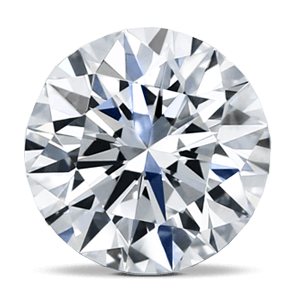
Round Cut Diamond
The 4 Cs of Round Cut Diamonds
Carat Weight
Carat weight serves as the determining factor for a round cut diamond’s size, a characteristic that often correlates with higher value for larger carat stones. Yet, the allure of a round diamond lies not only in its size but in the radiant dance of light it offers. Achieving the pinnacle of brilliance requires a delicate equilibrium, where carat weight harmonizes with the diamond’s cut, color, and clarity.
The artistry lies in striking this equilibrium, as even the most substantial carat stone can lack the mesmerizing sparkle if the other factors are not considered. It’s a masterful balance that skilled jewelers meticulously achieve, ensuring that the diamond’s captivating allure resonates far beyond its physical dimensions.
Color Grading
The captivating spectrum of diamond color is meticulously graded on a scale ranging from the pure brilliance of D (colorless) to the softer hues of Z (light yellow). Among the various diamond cuts, round cut diamonds emerge as masters of disguise, adeptly concealing any traces of color due to their exceptional light performance.
The intricate arrangement of facets within a round cut diamond acts as a captivating canvas, reflecting and refracting light with such finesse that it eclipses any hints of color that might be present.
This unique ability of round diamonds to exude a captivating radiance while maintaining a nearly colorless appearance underscores their timeless elegance and enduring desirability in the realm of fine jewelry.
Clarity Assessment
Within the realm of diamonds, clarity serves as a window into their inner world, revealing the subtle intricacies that nature has woven into their crystalline structure. Clarity is an appraisal of both internal and external flaws, the faint whispers of the diamond’s journey through time.
Although imperfections may trace their delicate patterns across the gem, the brilliance of a round cut diamond often casts a beguiling spell that distracts the eye from such subtle nuances.
The masterful play of light within the facets effectively conceals these imperfections, allowing the diamond’s captivating sparkle to take center stage, enchanting admirers with its luminous dance and leaving them captivated by its unparalleled allure.
Cut Quality
At the heart of a diamond’s splendor lies its cut—a complex interplay of artistry and science that orchestrates the gem’s luminous display. Undoubtedly the paramount factor shaping a diamond’s allure, the cut is a masterful manipulation of angles and facets that dictates how light interacts with the gem.
Within the realm of round brilliant cut diamonds, this artistry is elevated to an exquisite crescendo. When executed with precision, the cut transforms the diamond into a radiant spectacle, guiding light through its depths and reflecting it back in a captivating symphony.
A well-proportioned round diamond becomes a vessel for light, capturing its essence and transforming it into a breathtaking brilliance that seems to transcend the boundaries of the stone itself, radiating an effervescent glow that enchants all who gaze upon it.
Why Round Cut Diamonds Are Popular
The timeless appeal of round diamonds lies in their ability to effortlessly suit various styles, ensuring they remain in vogue across generations. From classic elegance to contemporary chic, these gems bridge the gap between eras, maintaining their popularity by resonating with diverse tastes.
Choosing the Perfect Round Cut Diamond
Setting Priorities: The 4 Cs
When choosing a round cut diamond, the four essential factors known as the 4 Cs—carat weight, color, clarity, and cut—demand careful consideration. These elements intricately interplay to define the diamond’s visual appeal and intrinsic worth.
Budget Considerations
Round cut diamonds extend an invitation to a wide array of budgets, offering a diverse selection that accommodates different financial considerations. The art lies in harmonizing the crucial elements encapsulated by the 4 Cs—carat weight, color, clarity, and cut—while staying within your designated budget.
This delicate equilibrium empowers you to make an informed and exquisite choice, where the brilliance of the diamond shines as brightly as your financial comfort allows.
Certification and Documentation
When it comes to ensuring the authenticity and quality of a round brilliant cut diamond, reputable certifications play an invaluable role. Organizations like the renowned Gemological Institute of America (GIA) hold the key to unlocking vital information about the diamond’s unique attributes and genuineness.
These certifications serve as a trustworthy roadmap for buyers, offering insights into the diamond’s cut, carat weight, color, and clarity, thereby empowering them to make an informed and confident choice.
Caring for Round Cut Diamond Jewelry
Cleaning and Maintenance
Nurturing the enduring beauty of round cut diamond jewelry necessitates a commitment to proper care. Regular maintenance rituals, such as gentle cleaning with mild soap and a soft brush, become the cornerstone of preserving the diamond’s captivating sparkle.
This routine not only removes accumulated dirt and residues but also safeguards the gem’s brilliance, allowing it to shine as brilliantly as the day it was acquired, a reflection of the enduring bond between the jewel and its wearer.
Storage Tips
The art of preserving round cut diamond jewelry extends to thoughtful storage practices. Safeguarding the gem’s allure involves storing it separately or within soft pouches, a precautionary measure that shields against potential scratches and tangling. Steering clear of abrasive surfaces becomes paramount, as the diamond’s pristine brilliance deserves to be protected from any harm.
By embracing these considerations, one not only ensures the diamond’s longevity but also upholds its radiant allure, a testament to the enduring commitment to its splendor.
Incorporating Round Cut Diamonds into Jewelry
Round Cut Engagement Rings
The enduring allure of round cut diamonds has solidified their position as a favored choice for crafting round diamond engagement rings that stand as symbols of everlasting love. Beyond the exquisite craftsmanship, it is the diamond’s brilliance that captures the essence of a couple’s eternal bond.
Each facet of the round cut becomes a mirror reflecting the enduring journey of two souls, igniting a dance of light that symbolizes the shared love, trust, and commitment.
The timeless elegance of the round diamond resonates with the timeless promise of a lifelong partnership, evoking emotions that echo through generations, a radiant reminder of the enduring love story that began with the exchange of this precious gem.
Necklaces and Pendants
Elevating any ensemble with a touch of sophistication and captivating sparkle, round cut diamonds suspended from necklaces or pendants effortlessly embrace the role of versatile adornments. These gems infuse a hint of glamour into everyday wear or elevate formal attire with their enchanting brilliance.
As they gracefully dangle, each facet of the round diamond captures and reflects light, casting a radiant glow that captivates the eye and adds a distinctive elegance to the wearer’s appearance. Whether worn as a statement piece or an understated accessory, these necklaces or pendants become a cherished embodiment of refined style and timeless beauty.
Earrings
Whether adorning earlobes as dazzling studs or cascading in captivating elegance as dangling accents, round cut diamond earrings effortlessly inject a touch of glamour into any ensemble. Their allure transcends occasions, but it’s their remarkable ability to elevate formal looks that truly sets them apart.
With every movement, the diamonds catch and reflect light, casting an enchanting glow that captures attention and adds a dash of sophistication to even the most refined occasions. These earrings become more than accessories; they become an expression of elegance and a celebration of the wearer’s unique style, accentuating the beauty within and illuminating the world around them.
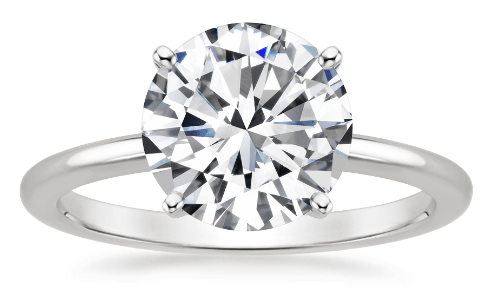
A Round Cut Diamond Solitaire Ring
The Symbolism of Round Cut Diamonds
Round cut diamonds serve as exquisite symbols of enduring concepts—eternity, unity, and everlasting love. It’s their circular form that becomes the visual embodiment of an unbreakable bond between individuals.
Like an unending loop, the diamond’s shape mirrors the infinite journey of shared moments, where love and unity circle back upon themselves, a reminder that the connection between two souls knows no bounds.
As the diamond graces a piece of jewelry, it resonates with the profound emotions that words sometimes struggle to convey, offering a silent testament to the everlasting nature of love’s embrace.
Round Cut Diamonds vs. Other Diamond Shapes
In a world where diamond shapes present diverse allure, the round cut’s allure stands resolute, driven by its unrivaled brilliance and remarkable versatility. While other shapes each possess their unique charm, the round cut’s brilliance reigns supreme, illuminating any setting with a dazzling display of light.
Its adaptability further solidifies its position as the prime choice for those who seek timeless elegance.
Whether set in a classic solitaire engagement ring, a vintage-inspired piece, or a modern design, the round cut effortlessly transforms into a masterpiece that transcends trends, its brilliance capturing the hearts of generations and serving as a captivating embodiment of enduring beauty.
Investing in Round Cut Diamonds
Embedded with the essence of love and beauty, round diamonds stand as enduring emblems of both sentiment and investment. Their ability to retain value over time is a testament to their intrinsic allure and enduring charm. This universal appeal translates into a consistent and unwavering demand within the market.
Regardless of shifting trends, the classic elegance of round diamonds remains unshaken, fostering a reliable and enduring desirability that assures their place as sought-after gems, cherished by those who adorn themselves with their radiant splendor and esteemed by collectors who recognize their lasting significance.
Round Cut Diamonds: Celebrities' Choice
A multitude of renowned celebrities have turned to round cut diamonds to grace their engagement rings and illuminate their red carpet ensembles, imbuing this classic gem with an aura of glamour and prestige. In a world where choices are abundant, their endorsement speaks volumes about the round cut’s timeless allure and universal charm.
By donning round cut diamond jewelry, these influential figures not only symbolize their personal connections but also elevate the cut to iconic status.
The stage of celebrity and elegance converges with the brilliance of the round cut, intertwining their legacies and solidifying its place as a celebrated choice that transcends trends and time, embodying a lasting fascination that remains eternally relevant.
Cultivating Trends: Round Cut Diamonds
In the realm of ever-evolving jewelry trends, round cut diamonds retain their captivating hold, seamlessly woven into the tapestry of both traditional and contemporary designs. Designers, inspired by the round cut’s enduring brilliance, are continuously crafting exquisite pieces that blend the charm of the past with the innovation of the present.
From vintage-inspired settings that evoke nostalgia to sleek, avant-garde creations that redefine elegance, round cut diamonds find their place as versatile and indispensable components of the modern jewelry landscape.
This continuous incorporation speaks to the timeless allure of the round cut, a gem that transcends fleeting fads and gracefully navigates the currents of change, firmly rooted in a legacy of beauty and grace that transcends generations.
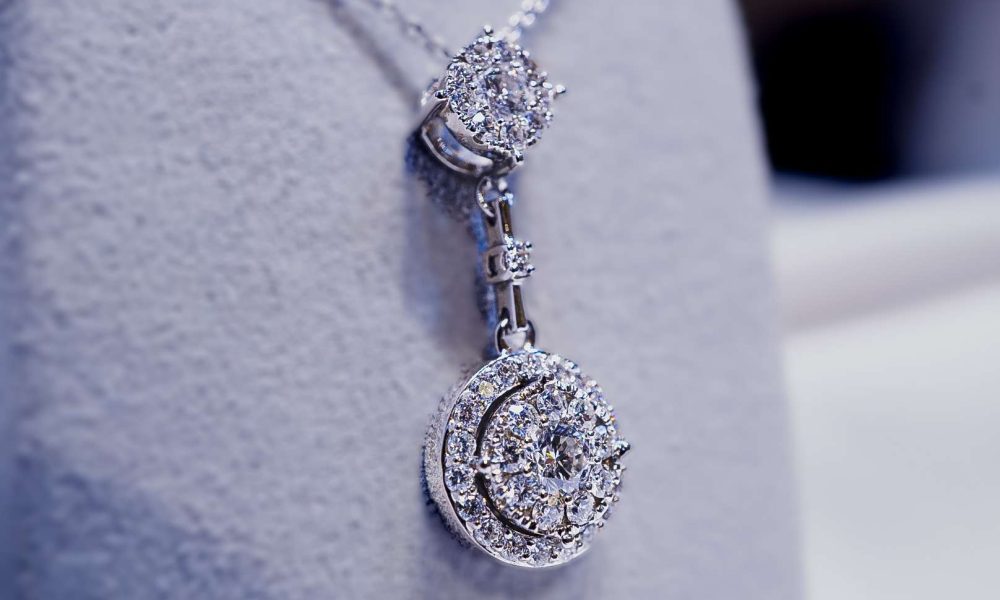
A Diamond Pendant
Final Thoughts
In the captivating realm of diamonds, the round brilliant cut diamond emerges as an exquisite testament to both enduring beauty and masterful craftsmanship. Its allure is a symphony of timelessness, characterized by an unmatched brilliance that captures the essence of light itself.
Beyond its radiance, the round diamond holds profound symbolic significance, representing unity, love, and the unbreakable circle of eternity. This storied gem is not merely a jewel; it’s a narrative encapsulated in facets, a reflection of moments cherished, and milestones celebrated.
As it graces fingers, necks, and ears across the ages, its legacy is one of unwavering elegance, a beacon of brilliance that bridges generations. This undeniable legacy ensures that the round diamond’s luminous journey will continue to illuminate the future with the same timeless splendor that has captivated hearts throughout history.
FAQs About Round Cut Diamonds
A round cut diamond is a gemstone with a circular shape and 58 or 57 facets, renowned for its exceptional brilliance.
Round diamonds' popularity stems from their unmatched sparkle, timeless elegance, and versatility that suits various styles.
Round diamonds' popularity stems from their unmatched sparkle, timeless elegance, and versatility that suits various styles.
The value depends on the 4 Cs: carat weight, color, clarity, and cut, with cut's impact on brilliance being crucial.
Yes, their facets' arrangement often conceals minor flaws, allowing their brilliance to shine, making imperfections less noticeable.
Absolutely, they complement a range of settings, from classic solitaires to intricate designs, adding sophistication to any piece.
The circular shape symbolizes unending love and unity, embodying a connection that transcends time and moments.
Yes, their enduring appeal and steady market demand make round diamonds an attractive investment in both sentiment and value.
Absolutely, their adaptability allows for various customization options, from settings to designs that reflect personal style.
Many celebrities have chosen round diamonds for their engagement rings and red carpet appearances, elevating their iconic status.
Regular cleaning with mild soap and a soft brush, along with careful storage in soft pouches, helps maintain its brilliance over time.

